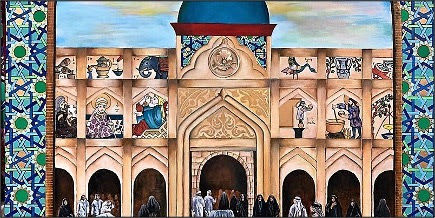Community

History
The History of Baghdad during
the 860's (Anarchy of Samarra)
Save 10% on officially licensed Assassin's
Creed Origins merchandise with the code "TOWCB"
Top Stories
12/9/22 By Michael Doyle Edited by Ashlea Blackett















Article may contain ads that support TOWCB.
Top Stories

861AD:
The anarchy began in 861 with the murder of the Caliph al-Mutawakkil by his Turkish guards, with the support of his own son, al-Muntasir.
Upon his death, his son al-Muntasir claimed the title of Caliphate, but this was short-lived. No more than 6-months into his rule, al-Muntasir was dead, having been poisoned by the Turkish Military Chiefs.

In our new article, we explore the history of Baghdad during the 860's, and the conflicts which took place during that time. In Assassin's Creed Mirage, scheduled for launch in 2023, players 'follow the transformation of a defiant young man into a refined Master Assassin with a conflicted destiny.'
Basim Ibn Ishaq will navigate the bustling streets of ninth–century Baghdad, exploring all four areas, from the industrial Karkh to the lush gardens of the Round City.
Here are some of the key events which took place during a period of extreme internal instability within the Abbasid Caliphate.
862AD:
Al-Muntasir was then succeeded by al-Musta’in, who was appointed Caliph by a council of Turkish military leaders. Al-Musta’in was the nephew of al-Mutawakkil and was appointed Caliph ahead of al-Muntasir’s brothers al-Mu’tazz and al-Mu’ayyad, the rightful inheritors of the Caliphate title. They were both quickly thrown in prison and forced to resign their titles to suppress their ability to rightly claim the title of Caliphate.
With his competition silenced, Al-Musta’in was then able to persuade the city of Baghdad in 862 to submit to his succession, which was eventually acknowledged throughout the land.
However, al-Mu’tazz and his brother continued to rally against Caliph al-Musta’in, and they were ultimately sentenced to death for their actions. Yet, this never came to pass. The Vizier (a senior minister of the Abbasid Caliphate) intervened, saving the brothers, and allowing them to flee. The Vizier was banished to the island of Crete for his actions.
863AD:
In 863, al-Musta’in, who was still living in the then capital Samarra (80miles north of Baghdad), still had plenty of conflicts to navigate as the governor of Baghdad. Two Greek priests, St. Cyril and St. Methodius had become missionaries and were spreading the Greek Orthodox version of Christianity throughout the region. al-Musta’in’s was campaigning against Christianity, but this was going badly, even resulting in the death of 8,000 troops and numerous military leaders.
These failures to protect the Muslim religion against the rise of Christianity saw riots across the city of Bagdad. Baghdadis cried for a Holy War, prisons were broken into, and bridges burnt, yet the Caliph didn’t listen or care.
864AD:
From 863 to 865 al-Musta’in continued to lose the trust of his people, with much of the region slipping into chaos and fighting men from surrounding provinces having flocked to Baghdad and Samarra to fight and plunder.
865AD:
In 865, the rule of al-Musta’in was slowly falling apart. After disagreements with the Turkish leaders, al-Musta’in felt that his life was in danger. So, alongside the company of two other Turkish leaders, Bugha al-Sharabi and Wasif al-Turki, he left Samarra on a boat to East Baghdad.
The Turkish leaders, upon hearing of al-Musta’in’s sent a party of captains to apprehend the Caliph and requested that he returned to the capital of Samarra. Al-Musta’in refused, and after a heated discussion with the Turkish speakers, one of them received a blow. This insulted the Turkish officers, and upon their return to Samarra, they brought al-Mu’tazz (the rightful Caliph) out from his confinement and appointed him as Caliph.
Within a few weeks, the new Caliph al-Mu’tazz and his brother Abu Ahmad al-Muwaffaq, along with 50,000 Turks and 2,000 Berbers besieged Baghdad.
The Abbasid civil war, which lasted for about a year, largely revolved around a prolonged siege of Baghdad and resulted in the continued scarcity of food and money in the city. As the conflict raged on, members of the Abbasid family with Baghdad, without the knowledge or permission of al-Musta’in, had opened negotiations with the new Caliph al-Mu’tazz regarding the surrender of al-Musta’in. The first round of negotiations deteriorated, and the
siege continued whilst the Baghdadi people protested in the streets at the news that leader al-Musta’in, whom they still saw as the Caliph, was to be disposed of.
866AD:
Ultimately, in January of 866, al-Musta’in was convinced to abdicate by his fellow Turkish officers, Wasif and Bugha, and he stepped down as Caliph. Upon his abdication, an agreement was set that his life would be spared and that he would receive sufficient income and a home in Medina.
On Friday 25th January 866, al-Mu’tazz was acknowledged as Caliph in the mosques throughout Baghdad.
Despite the agreement set out upon his abdication, al-Musta’in was not granted a home in Medina and was instead kept within the city of Baghdad. Ultimately, he was executed on the 17th of October 866 by order of the Caliph Al-Mu’tazz, who was playing a game at the time, later awarding the assassin 500 pieces as a reward.
How will Basim fit into the history of Baghdad?
-
With many high-profile assassinations during the 860s in Baghdad, will Basim and the guild be connected in some way to these assassinations?
-
Will the Vizier play a role in Mirage, his intervention in the murder of the brothers could indicate a connection to the guild?
-
Will the two Greek priests, who spread Christianity across the land be connected to the events of Mirage? We know their actions caused uprising and riots in Baghdad, but will they be portrayed in the game?
-
Will Basim have some role to play in the success or failure of al-Musta’in and his fellow Turkish troops fleeing to Baghdad in 864?
-
Will Basim fight in the siege of Baghdad during the Abbasid Civil War?
-
Will Basim and the guild influence the negotiations between the members of the Abbasid family and al’Mu’tazz?
-
Will any of the Caliph’s during this timeframe be part of the Order of Ancients?
Art by Al (Its A Creed) from the AC Partnership Program
About the Author
Michael is a passionate Assassin's Creed fan who recently joined TOWCB AC
Partnership Program as an Online Article Writer.
Throughout 2022, Michael and other writers will be joining the admin team in a collaborative effort to create an Assassin's Creed Valhalla Guide Database, which you can find here.

Michael Doyle
AC Mirage Concept Art by FrameHoldPhotography, created using Valhalla/ Origins & Photoshop


















